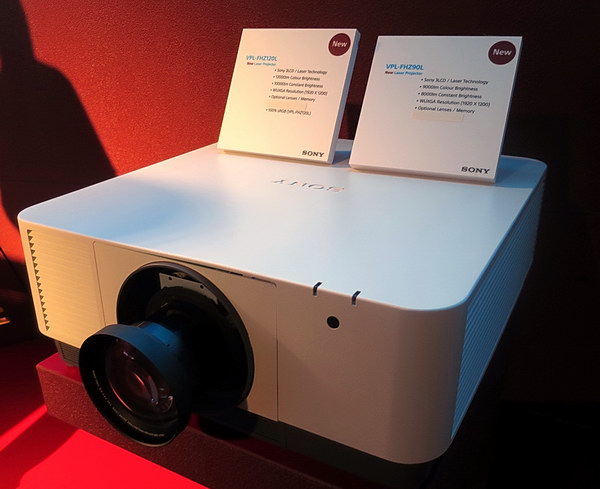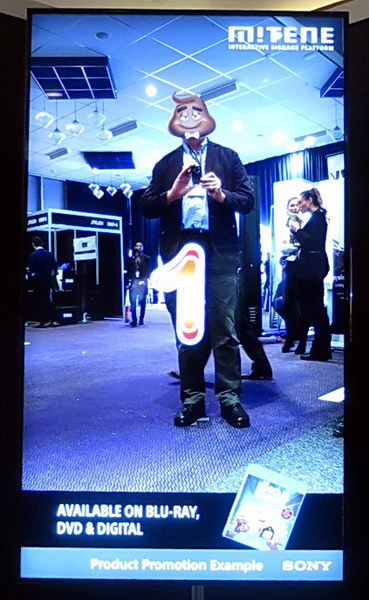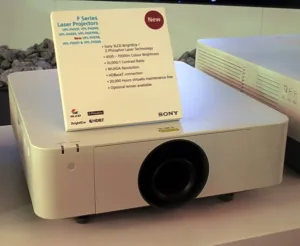At ISE, Sony showed five new projectors, including the VPL-FHZ120L, VPL-FHZ90L VPL-FHZ58, VPF-FHZ61 and VPF-FHZ68. Each is designed for a range of commercial mid-range installation applications, including education, faith, corporate and museums. Not surprisingly, all the new projectors are laser-based. In addition, all five projectors are based on 3LCD engines.
 The Sony VPL-FHZ120L, VPL-FHZ90L look identical. (Credit: M. Brennesholtz)
The Sony VPL-FHZ120L, VPL-FHZ90L look identical. (Credit: M. Brennesholtz)
The FHZ120L and FHZ90L projectors are Sony’s first venture beyond 7K lumens in the FHZ series, according to Sony representative Robert Meakin. The projectors use a new WUXGA (1920 x 1200 x 3) BrightEra 1” LCD panel. They have a 20,000 hour light source to a 70% brightness level. While they have a filter, it has a scheduled 20,000 hour cleaning or replacement cycle. When asked, Meakin added that the inorganic LCD alignment layer meant that he had rarely heard of current problems with degradation of the blue LCD compared to the red or green one, a serious problem for 3LCD projectors from only a few years ago.
These two projectors have powered lens shift and either powered or manual focus and zoom, depending on the lens chosen. The six available lenses include a fixed 1.0:1 throw ratio, four zoom lenses that cover the range from 1.3:1 to 5.58:1 and another zoom lens that covers the throw ratio range from 6.08:1 to 10.52:1.
Inputs are RGB/Y PB PR on 5 x BNC connectors, DVI with HDCP 1.4, HDMI with HDCP 1.4, and HDBaseT. There is a VGA monitor output. The USB Type-A connector is for maintenance.
The Sony VPL-FHZ58, VPF-FHZ61 and VPF-FHZ68 projectors also look virtually identical. (Credit: M. Brennesholtz)
The VPL-FHZ58, VPF-FHZ61 and VPF-FHZ68 projectors represent upgrades to the existing FHZ models and use the same 0.76” panel used by other FHZ projectors. Lumen output of the three projectors are 4,200, 5,100 and 6,100 lumens, respectively. They have WUXGA (1920 x 1200) resolution, 10,000: contrast and a HDBaseT connection. The light source is good for 20,000 hours and the projectors are described as “20,000 hours virtually maintenance free.” Full specifications on these new models are not yet available.
Pre-orders for each of the new models will begin in April, with planned availability for the five new models beginning in summer 2018.
AR Digital Signage
In a separate booth in the small AR/VR area at ISE, Sony was showing its Mintene AR digital signage system. Jonas Leijon, Business Developer at the UX Business Development Division gave me a complete demonstration of the system.
 The Sony Mitene Digital Signage system has replaced my face with the face of a character in the Emoji Movie. (Credit: M. Brennesholtz)
The Sony Mitene Digital Signage system has replaced my face with the face of a character in the Emoji Movie. (Credit: M. Brennesholtz)
The Mitene system takes an image, using a Sony camera, of course, and processes it to replace part of the image with a customer-chosen object. In the demo at ISE, the system was replacing viewer’s faces with characters from the Emoji Movie, as shown in the image. Leijon told me the system can focus on other things and, for example, put a handbag in the hand of the viewer, leaving the face unchanged. As the subject moved around, the software tracked and the face or the handbag moved with the subject. The software also had an option to save the picture for later download by the viewer. Given the current quality of the image (Not bad, really, but a bit cartoonish!) I would say at present the system is more suited for promoting the Emoji Movie than high-end handbags.
 Mitene system layout. (Credit: Sony)
Mitene system layout. (Credit: Sony)
While the image processing for the display is done locally, the system control and the data analytics are done in the cloud.
Cledis Now Colour-managed
Sony was highlighting that its Cledis solution is now fully colour managed, so that the colour accuracy can be matched with other displays. This is the result of an improved controller which can support HDR in PQ or Sony’s SLog3. As before, it looked very good, in an 8K x 2K format (which is reported to have taken around 50 hours to build) and in a smaller, 120″ format. We heard that the price is still around €55,000/m² (and the 120″ is reported to be priced at about $500,000).
Flat Panels Just Part of Solutions
Sony in the flat panel area was focusing entirely on solutions, rather than on devices, so we didn’t get any news on its latest Bravia commercial displays. The range of solutions that is being developed included the Teos sub-brand for management software for meeting control and room booking. Sony is supplying devices for this as well and we looked at the TEB-10DSQPL Teos Book which is a 10.1″ Android device that is powered by PoE and intended for 24/7 operation. The TeosBook can also be used for wayfinding or for reception control and Sony is using a single software platform for room booking as well as CMS functions. The platform can push content to a wide range of Sony devices.

As we have reported before from BETT last year, Sony has a lot of interest in educational solutions and at ISE, the company showed us the latest developments in its Active Learning technology. (BETT 2017 Round-up) Education, especially higher education, is moving away from simple communication of knowledge (my wife, who teaches, calls this the ‘sage on a stage’ approach! Man. Ed.) to providing the conditions for students to explore knowledge. The Sony system (PES-C100) supports up to ten groups or huddle groups with their own systems. The teacher can monitor the groups and can control the displays to allow sharing and screen mirroring and annotation. The displays being used were 55″ Bravia professional units with PCap touch technology (FW-55XE8501).
 Sony showed how its PES C100 workgroup device could be used for education. Image:Meko
Sony showed how its PES C100 workgroup device could be used for education. Image:Meko
–Matthew Brennesholtz & Bob Raikes

